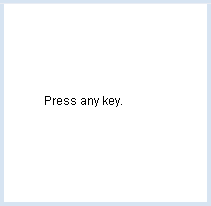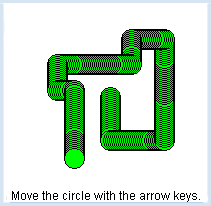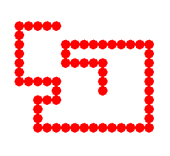3.6 KEYBOARD CONTROLS
![]()
INTRODUCTION |
|
Programs become especially interactive when the user can control the program execution by using keys on the keyboard. Although keystrokes are actually events that always occur independently of the program, they can be captured also through querying functions. |
KEYBOARD CONTROLS |
|
MEMO |
|
You can use the command getKeyCodeWait() for keyboard inputs. The computer waits until you press a key and then returns the key code. However, you have to remember that the GPanel window must be active. In other words, it must be in focus. If the window loses focus, you have to click somewhere inside it in order to activate it again. Only the currently active window receives keyboard events. |
CONTROLLING FIGURES |
from gpanel import * KEY_LEFT = 37 KEY_RIGHT = 39 KEY_UP = 38 KEY_DOWN = 40 def drawCircle(): move(x, y) setColor("green") fillCircle(5) setColor("black") circle(5) makeGPanel(0, 100, 0, 100) text("Move the circle with the arrow keys.") x = 50 y = 50 step = 2 drawCircle() while True: key = getKeyCodeWait() if key == KEY_LEFT: x -= step drawCircle() elif key == KEY_RIGHT: x += step drawCircle() elif key == KEY_UP: y += step drawCircle() elif key == KEY_DOWN: y -= step drawCircle() |
MEMO |
|
To make the program more readable, you can introduce constants for the keyboard codes of the arrow keys. So that they are especially noticeable, constants should be placed in the program header and written in capital letters. |
NON-BLOCKING KEYBOARD QUERIES |
You want the speed of a ball moving back and forth to get slower with the letter key 's' (for slow) and get faster with 'f' (for fast), but only up to a certain maximum value. You need to again focus your attention on the event loop, which is where everything essential happens. In it, kbhit() periodically queries, whether a key was hit or not. If this is the case, kbhit() returns True and you can get the key code by using getKeyCode(). from gpanel import * import time KEY_S = 83 KEY_F = 70 makeGPanel(0, 600, 0, 600) title("Key 'f': faster, 's': slower") enableRepaint(False) x = 300 y = 300 v = 10 vmax = 50 isAhead = True while True: startTime = time.clock() if kbhit(): key = getKeyCode() if key == KEY_F: if v < vmax: v += 1 elif key == KEY_S: if v > 0: v -= 1 clear() setColor("black") text(10, 10, "Speed: " + str(v)) if isAhead: x = x + v else: x = x - v move(x, y) setColor("red") fillCircle(20) repaint() if x > 600 or x < 0: isAhead = not isAhead while (time.clock() - startTime) < 0.010: delay(1) |
MEMO |
|
Since it is an animation, we again need to use an animation timer in order to obtain a run through the event loop that is as periodic as possible. The next game state is created in the loop and it is then displayed in the window screen with repaint(). kbhit() returns a truth value, which we refer to as a boolean. If a key was pressed since the last call, it returns True, otherwise False. |
EXERCISES |
|



